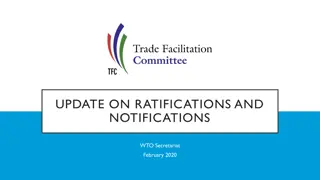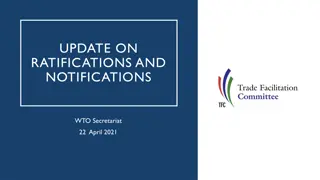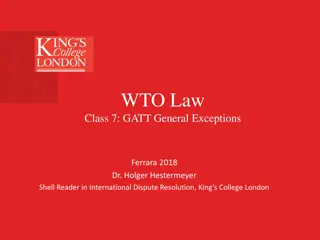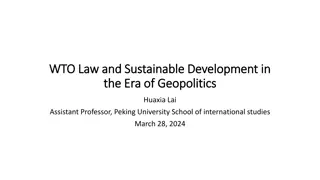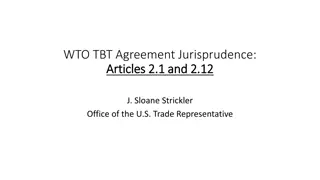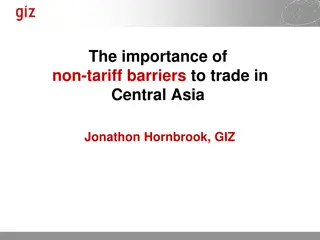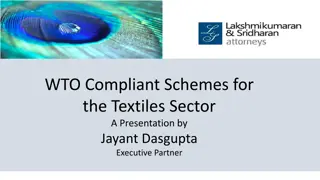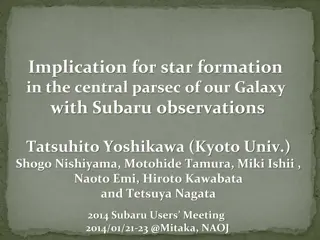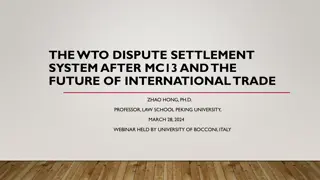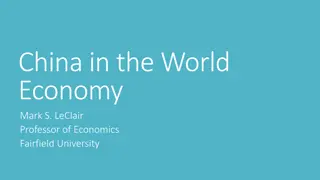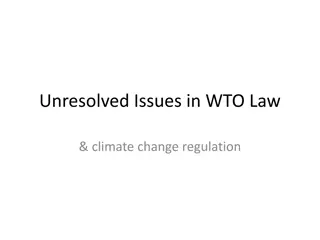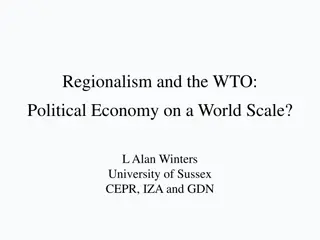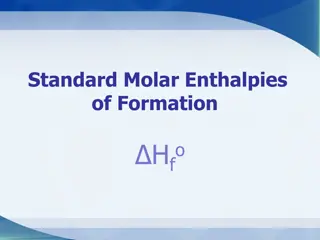
Formation and Objectives of WTO
The World Trade Organization (WTO) was established in Geneva, Switzerland, with a membership of 164 states, including India since 1 January 1995. It aims to promote global trade by reducing barriers, improving living standards, encouraging production, and fostering sustainable development. The organization was formed under the Uruguay Round of GATT and focuses on non-discrimination and promoting fair trade practices.
Download Presentation

Please find below an Image/Link to download the presentation.
The content on the website is provided AS IS for your information and personal use only. It may not be sold, licensed, or shared on other websites without obtaining consent from the author. If you encounter any issues during the download, it is possible that the publisher has removed the file from their server.
You are allowed to download the files provided on this website for personal or commercial use, subject to the condition that they are used lawfully. All files are the property of their respective owners.
The content on the website is provided AS IS for your information and personal use only. It may not be sold, licensed, or shared on other websites without obtaining consent from the author.
E N D
Presentation Transcript
WTO Its Headquarters: Geneva, Switzerland. Its Director General is Ngozi Okonjo-Iweala Membership: 164 member states India is the member of WTO since 1 January 1995. Formed under Uruguay Round of GATT under the Marrakesh agreement.
History Great Depression in 1930s which started from USA on 4 Sep 1929 which resulted in worldwide stock market crash on 29 October 1929. Following which Tariff War started which was one of the economic factor of World War 2 from 1939 to 1945 Bretton Wood Conference Monetary & Financial Conference happened at New Hampshire, USA from 1 July to 22 July 1944. also called UN
The Conference lead to the formation of 1. International Bank for Reconstruction and Development which later became World Bank. 2. IMF 3. Discussion Related to regulation of World Trade
Geneva Conference was held in 1947 which lead to signing of General Agreement on Tariff and Trade (GATT). It was signed by 23 countries on 30 October 1947 and came into effect on 1 January 1948.
Uruguay Round Conference Uruguay Round Conference from 1986 to 1994 had discussions to convert GATT into an Organization. WTO was formed under Marrakesh agreement at Morocco.
Reasons behind formation of WTO GATT included only tariff barriers, thus non tariff barriers were increased by the countries by 1970s. Shift of Comparative Advantage of developed countries from Manufactured Goods to Services. Demand by developing countries to include Trade in Agriculture and Textile to be included in international trade.
Objectives 1. Promote world trade by reducing trade barriers. 2. Improve living standards of people. 3. To encourage production and trade of goods and services. 4. To promote sustainable development.
Principles 1. Non discrimination Non-Discrimination has two aspects: A. Most favoured nation (MFN) and B. National Treatment. A. Most favoured nation (MFN): Under the MFN, all WTO member countries should be treated equally, without discrimination. For example- India decides to lower basic customs duty for imports of iron-ore from China. This favour will have to be extended to all other countries. B. National Treatment Foreign goods and local goods must be treated equally. 2. Fair Competition -Discouraging unfair practices, such as export subsidies and dumping products at below normal value to gain market share; the issues are complex, and the rules try to establish what is fair or unfair, and how governments can respond, in particular by charging additional import duties calculated to compensate for damage caused by unfair trade.
3.Free Trade: All trade barriers should be lowered gradually through negotiations. 4.Predictability and transparency: Foreign companies, investors and governments should be confident that trade barriers will not be raised arbitrarily. With stability and predictability, investment is encouraged, jobs are created and consumers can fully enjoy the benefits of competition such as increased choice and lower prices. 5.Encourage development and economic reform
Structures of WTO 1. Ministerial Conference The structure of the WTO is dominated by its highest authority, the Ministerial Conference, composed of representatives of all WTO members, which is required to meet at least every two years and which can take decisions on all matters under any of the multilateral trade agreements. 1. General Council The day-to-day work of the WTO, however, falls to a number of subsidiary bodies; principally the General Council, also composed of all WTO members, which is required to report to the Ministerial Conference. As well as conducting its regular work on behalf of the Ministerial Conference. The General Council convenes in two particular forms - as the Dispute Settlement Body, to oversee the dispute settlement procedures and as the Trade Policy Review Body to conduct regular reviews of the trade policies of individual WTO members.
The General Council delegates responsibility to three other major bodies 1. Councils for Trade in Goods 2. Trade in Services 3. Trade-Related Aspects of Intellectual Property. 1. The Council for Goods oversees the implementation and functioning of all the agreements covering trade in goods, though many such agreements have their own specific overseeing bodies. 2. The latter two Councils have responsibility for their respective WTO agreements and may establish their own subsidiary bodies as necessary.
Reports 1. World Trade Report 2. World Trade Statistical Report

